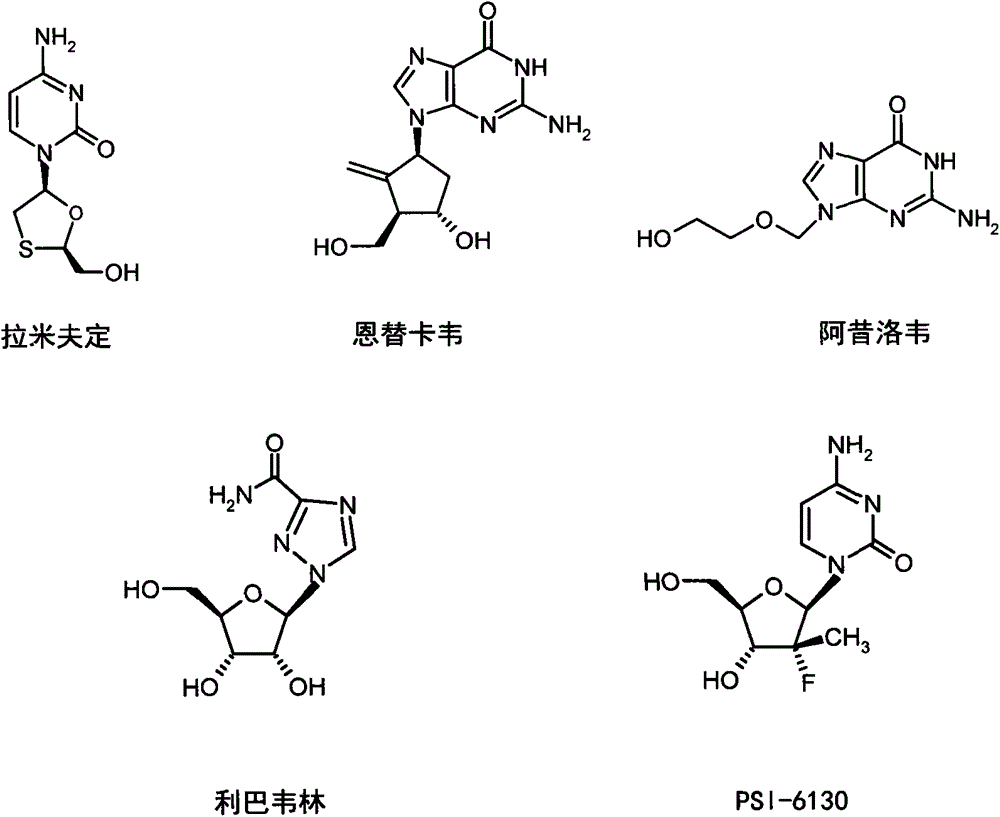Phosphoric acid/phosphonic acid derivatives and medical applications thereof
A technology of phosphonic acid derivatives and derivatives, which can be used in sugar derivatives, pharmaceutical formulations, medical preparations containing active ingredients, etc., and can solve problems such as carcinogenesis
- Summary
- Abstract
- Description
- Claims
- Application Information
AI Technical Summary
Problems solved by technology
Method used
Image
Examples
preparation example Construction
[0060] Preparation of Thio-cytidine (Cf1109)
[0061]
[0062] Dissolve 2.1 g (0.01 mol) of phenol dichlorophosphate and 1.3 g (0.01 mol) of L-alanine methyl ester in 30 mL of anhydrous dichloromethane, and cool to -78°C. A solution of 2 ml of triethylamine dissolved in 20 mL of anhydrous dichloromethane was added dropwise with stirring, and the rate of addition was controlled to maintain the reaction temperature at -78°C. After the addition was complete, the reaction temperature was gradually raised to room temperature, and stirring was continued for 1 hour. The solvent was distilled off under reduced pressure, and 30 ml of anhydrous diethyl ether was added to the residue, and filtered. Evaporate the filtrate to dryness under reduced pressure to obtain a colorless oil, which is the phosphoramide intermediate V 1 , used directly in the next reaction.
[0063] Dissolve 0.21g of lamivudine in 50ml of THF, then add 7ml of pyridine, blow nitrogen, add 1ml of 1M THF solution ...
Embodiment 1
[0083] Example 1 9-[[[bis-((benzo[1,3]dioxol-4-yl)-oxyl)-phosphono]-methoxy]-ethyl]-adenine (I 1 ) preparation
[0084]
[0085] Add 13.7g 9-[(phosphono-methoxy)-ethyl]-adenine (PMEA) and 13.8g 4-hydroxybenzo[1,3]dioxane to 100ml N-methylpyrrolidone, heat Stir at 90°C, then add 10ml of triethylamine and 20g of dicyclohexylcarbodiimide in sequence, and heat and stir at 90°C for 15 hours. Natural cooling overnight, the solid was filtered off; the filtrate was concentrated under reduced pressure, the residue was dissolved in ethyl acetate, washed successively with a saturated solution of sodium carbonate (2×200ml) and a saturated solution of sodium chloride (2×200ml), and the organic layer was washed with anhydrous sulfuric acid The sodium was dried overnight, the desiccant was filtered off, the filtrate was evaporated to dryness under reduced pressure, separated by silica gel column chromatography, and eluted with a mixed solvent of dichloromethane:methanol (20:1), the desir...
Embodiment 2
[0086] Example 2 9-[[[bis-((benzo[1,3]dioxol-5-yl)-oxyl)-phosphono]-methoxy]-ethyl]-adenine (I 2 ) preparation
[0087]
[0088] Referring to the method of Example 1, 5-hydroxybenzo[1,3]dioxane was used instead of 4-hydroxybenzo[1,3]dioxane, condensed with PMEA, treated and separated and purified by a similar method, Obtain target compound I 2 , yield 14%. Proton NMR spectrum δ (ppm, DMSO-d6): 8.15(s, 1H); 8.11(s, 1H); 7.32(b, 2H); 6.77-6.75(d, 2H); 6.68(s, 2H); 6.49-6.47 (d, 2H); 5.99 (s, 4H); 4.35-4.33 (t, 2H); 3.93-3.91 (t, 2H); 3.80-3.78 (d, 2H).
PUM
 Login to View More
Login to View More Abstract
Description
Claims
Application Information
 Login to View More
Login to View More - Generate Ideas
- Intellectual Property
- Life Sciences
- Materials
- Tech Scout
- Unparalleled Data Quality
- Higher Quality Content
- 60% Fewer Hallucinations
Browse by: Latest US Patents, China's latest patents, Technical Efficacy Thesaurus, Application Domain, Technology Topic, Popular Technical Reports.
© 2025 PatSnap. All rights reserved.Legal|Privacy policy|Modern Slavery Act Transparency Statement|Sitemap|About US| Contact US: help@patsnap.com



